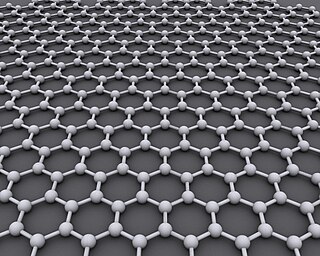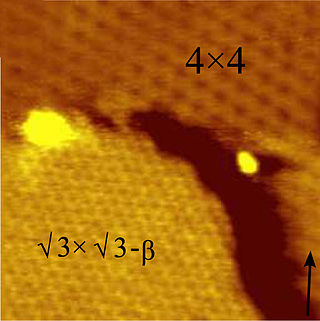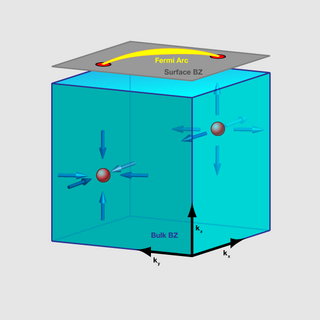Related Research Articles

SLAC National Accelerator Laboratory, originally named the Stanford Linear Accelerator Center, is a federally funded research and development center in Menlo Park, California, United States. Founded in 1962, the laboratory is now sponsored by the United States Department of Energy and administrated by Stanford University. It is the site of the Stanford Linear Accelerator, a 3.2 kilometer (2-mile) linear accelerator constructed in 1966 that could accelerate electrons to energies of 50 GeV.

In physics, the Kondo effect describes the scattering of conduction electrons in a metal due to magnetic impurities, resulting in a characteristic change i.e. a minimum in electrical resistivity with temperature. The cause of the effect was first explained by Jun Kondo, who applied third-order perturbation theory to the problem to account for scattering of s-orbital conduction electrons off d-orbital electrons localized at impurities. Kondo's calculation predicted that the scattering rate and the resulting part of the resistivity should increase logarithmically as the temperature approaches 0 K. Experiments in the 1960s by Myriam Sarachik at Bell Laboratories provided the first data that confirmed the Kondo effect. Extended to a lattice of magnetic impurities, the Kondo effect likely explains the formation of heavy fermions and Kondo insulators in intermetallic compounds, especially those involving rare earth elements such as cerium, praseodymium, and ytterbium, and actinide elements such as uranium. The Kondo effect has also been observed in quantum dot systems.

Graphene is an allotrope of carbon consisting of a single layer of atoms arranged in a hexagonal lattice nanostructure. The name is derived from "graphite" and the suffix -ene, reflecting the fact that the graphite allotrope of carbon contains numerous double bonds.

In physics, topological order is a kind of order in the zero-temperature phase of matter. Macroscopically, topological order is defined and described by robust ground state degeneracy and quantized non-Abelian geometric phases of degenerate ground states. Microscopically, topological orders correspond to patterns of long-range quantum entanglement. States with different topological orders cannot change into each other without a phase transition.
In particle physics, a relativistic particle is an elementary particle with kinetic energy greater than or equal to its rest-mass energy given by Einstein's relation, , or specifically, of which the velocity is comparable to the speed of light .
The quantum spin Hall state is a state of matter proposed to exist in special, two-dimensional semiconductors that have a quantized spin-Hall conductance and a vanishing charge-Hall conductance. The quantum spin Hall state of matter is the cousin of the integer quantum Hall state, and that does not require the application of a large magnetic field. The quantum spin Hall state does not break charge conservation symmetry and spin- conservation symmetry.

A topological insulator is a material whose interior behaves as an electrical insulator while its surface behaves as an electrical conductor, meaning that electrons can only move along the surface of the material.

Silicene is a two-dimensional allotrope of silicon, with a hexagonal honeycomb structure similar to that of graphene. Contrary to graphene, silicene is not flat, but has a periodically buckled topology; the coupling between layers in silicene is much stronger than in multilayered graphene; and the oxidized form of silicene, 2D silica, has a very different chemical structure from graphene oxide.
Bilayer graphene is a material consisting of two layers of graphene. One of the first reports of bilayer graphene was in the seminal 2004 Science paper by Geim and colleagues, in which they described devices "which contained just one, two, or three atomic layers"

Shoucheng Zhang was a Chinese-American physicist who was the JG Jackson and CJ Wood professor of physics at Stanford University. He was a condensed matter theorist known for his work on topological insulators, the quantum Hall effect, the quantum spin Hall effect, spintronics, and high-temperature superconductivity. According to the National Academy of Sciences:
He discovered a new state of matter called topological insulator in which electrons can conduct along the edge without dissipation, enabling a new generation of electronic devices with much lower power consumption. For this ground breaking work he received numerous international awards, including the Buckley Prize, the Dirac Medal and Prize, the Europhysics Prize, the Physics Frontiers Prize and the Benjamin Franklin Medal.

Charles L. Kane is a theoretical condensed matter physicist and is the Christopher H. Browne Distinguished Professor of Physics at the University of Pennsylvania. He completed a B.S. in physics at the University of Chicago in 1985 and his Ph.D. at Massachusetts Institute of Technology in 1989. Prior to joining the faculty at the University of Pennsylvania he was a postdoctoral associate at IBM's T. J. Watson Research Center working with his mentor Matthew P. A. Fisher, among others.
In materials science, the term single-layer materials or 2D materials refers to crystalline solids consisting of a single layer of atoms. These materials are promising for some applications but remain the focus of research. Single-layer materials derived from single elements generally carry the -ene suffix in their names, e.g. graphene. Single-layer materials that are compounds of two or more elements have -ane or -ide suffixes. 2D materials can generally be categorized as either 2D allotropes of various elements or as compounds.

Weyl fermions are massless chiral fermions embodying the mathematical concept of a Weyl spinor. Weyl spinors in turn play an important role in quantum field theory and the Standard Model, where they are a building block for fermions in quantum field theory. Weyl spinors are a solution to the Dirac equation derived by Hermann Weyl, called the Weyl equation. For example, one-half of a charged Dirac fermion of a definite chirality is a Weyl fermion.

Dirac cones, named after Paul Dirac, are features that occur in some electronic band structures that describe unusual electron transport properties of materials like graphene and topological insulators. In these materials, at energies near the Fermi level, the valence band and conduction band take the shape of the upper and lower halves of a conical surface, meeting at what are called Dirac points.
The term Dirac matter refers to a class of condensed matter systems which can be effectively described by the Dirac equation. Even though the Dirac equation itself was formulated for fermions, the quasi-particles present within Dirac matter can be of any statistics. As a consequence, Dirac matter can be distinguished in fermionic, bosonic or anyonic Dirac matter. Prominent examples of Dirac matter are Graphene, topological insulators, Dirac semimetals, Weyl semimetals, various high-temperature superconductors with -wave pairing and liquid Helium-3. The effective theory of such systems is classified by a specific choice of the Dirac mass, the Dirac velocity, the Dirac matrices and the space-time curvature. The universal treatment of the class of Dirac matter in terms of an effective theory leads to a common features with respect to the density of states, the heat capacity and impurity scattering.
Eugene John "Gene" Mele is a professor of physics at the University of Pennsylvania, where he researches quantum electric phenomena in condensed matter.
Plumbene is a material made up of a single layer of lead atoms. The material is created in a process similar to that of graphene, silicene, germanene, and stanene, in which high vacuum and high temperature are used to deposit a layer of lead atoms on a substrate. High-quality thin films of plumbene have revealed two-dimensional honeycomb structures. First researched by Indian scientists, further investigations are being done around the world.
Photonic topological insulators are artificial electromagnetic materials that support topologically non-trivial, unidirectional states of light. Photonic topological phases are classical electromagnetic wave analogues of electronic topological phases studied in condensed matter physics. Similar to their electronic counterparts, they, can provide robust unidirectional channels for light propagation.
Dirk Robert Englund is an Associate Professor of Electrical Engineering and Computer Science at the Massachusetts Institute of Technology. He is known for his research in quantum photonics and optical computing.
Fractional Chern insulators (FCIs) are lattice generalizations of the fractional quantum Hall effect that have been studied theoretically since the early 2010's. They were first predicted to exist in topological flat bands carrying Chern numbers. They can appear in topologically non-trivial band structures even in the absence of the large magnetic fields needed for the fractional quantum Hall effect. They promise physical realizations at lower magnetic fields, higher temperatures, and with shorter characteristic length scales compared to their continuum counterparts. FCIs were initially studied by adding electron-electron interactions to a fractionally filled Chern insulator, in one-body models where the Chern band is quasi-flat, at zero magnetic field. The FCIs exhibit a fractional quantized Hall conductance.
References
- ↑ DOE/SLAC National Accelerator Laboratory (2013-11-21). "Will 2-D tin be the next super material?". Sciencedaily.com . Retrieved 2014-01-10.
- ↑ Garcia, J. C.; de Lima, D. B.; Assali, L. V. C.; Justo, J. F. (2011). "Group IV Graphene- and Graphane-Like Nanosheets". J. Phys. Chem. C. 115: 13242. doi:10.1021/jp203657w.
- ↑ "Will 2-D tin be the next super material?". Phys.org. 21 November 2013. Retrieved 2014-01-10.
- ↑ Xu, Yong; Yan, Binghai; Zhang, Hai-Jun; Wang, Jing; Xu, Gang; Tang, Peizhe; Duan, Wenhui; Zhang, Shou-Cheng (2013-09-24). "Large-Gap Quantum Spin Hall Insulators in Tin Films". Physical Review Letters. 111 (13): 136804. arXiv: 1306.3008 . doi:10.1103/PhysRevLett.111.136804. ISSN 0031-9007. PMID 24116803. S2CID 11310025.
- ↑ Singh, Ritu (November 24, 2013). "Tin could be the next super material for computer chips". Zeenews .
- ↑ Markoff, John (January 9, 2014). "Designing the Next Wave of Computer Chips". New York Times . Retrieved January 10, 2014.
- ↑ "Will 2-D Tin be the Next Super Material?" (Press release). Stanford University: SLAC National Accelerator Laboratory. November 21, 2013.